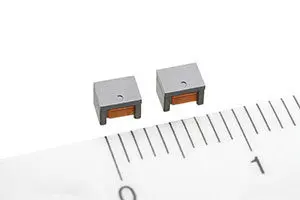source: TDK news
TDK Corporation presents the new ADL3225V choke for automotive power over coax (PoC) applications.
The wire wound inductor, which has a DC resistance of 0.9 Ω, features high impedance over a broad frequency spectrum of 1 MHz up to 1 GHz. The new type offers good DC superimposition characteristics, thus separating the power from the signal path, for example, for the signals of sensors and cameras that are connected via automotive Ethernet. The rated inductance of the choke is 47 µH and their rated current (Isat) is 300 mA. The new choke, which is qualified to AEC-Q200, is available with compact dimensions of 3.2 mm x 2.5 mm x 2.4 mm. Mass production of the ADL3225V is scheduled to begin in April 2017.
PoC applications require high impedance at the branch of the power line and the signal line in order to prevent the high-frequency signal from causing interference on the power line with its low load impedance. TDK’s proprietary structural design and winding combined with the fully automated manufacturing process ensures the excellent electrical properties and high reliability of the new inductors.
The growing number of sensors and cameras in cars is driving the need to speed up the communications between the many ECUs (electric control unit). Advanced communication protocols such as automotive Ethernet with a data rate of up to 100 Mbit/s and low-voltage differential signaling (LVDS) with a transmission rate of up to 1.5 Gbit/s) are both being used for the image signals from on-board camera to the main circuit board. PoC, in which both the data and power are transmitted simultaneously over the same coaxial cable, serves to reduce the weight of wire harnesses and improve fuel consumption.
In the future, TDK will further expand the lineup with more compact types and higher operating temperatures for an even wider variety of automotive applications.
Main applications
- PoC for automotive camera systems
Main features and benefits
- Data and power signals are separated with high impedance over a broad frequency spectrum of up to 1 GHz.
- Good DC superimposition characteristics
- High reliability thanks to fully automated production processes
Key data
-
Type Inductance
[µH]DC resistance
[Ω]Rated current [mA] Isat* Itemp ** ADL3225V-470MT-TL000 47 ±20% 0.9 (max.) 300 (typ.) 500 (typ.) *Isat Based on the inductance change rate (30% below the initial inductance value)
**Itemp Based on the temperature increase (temperature increase of 40°C by self-heating)































